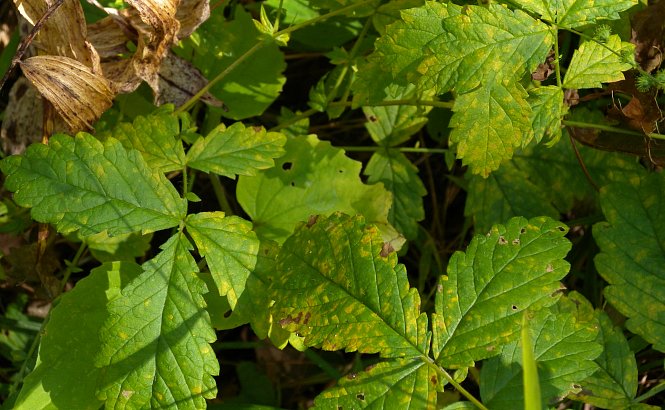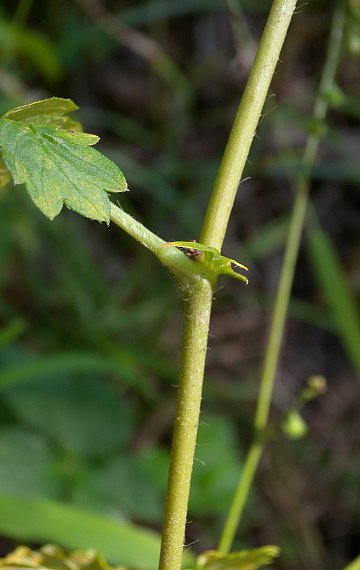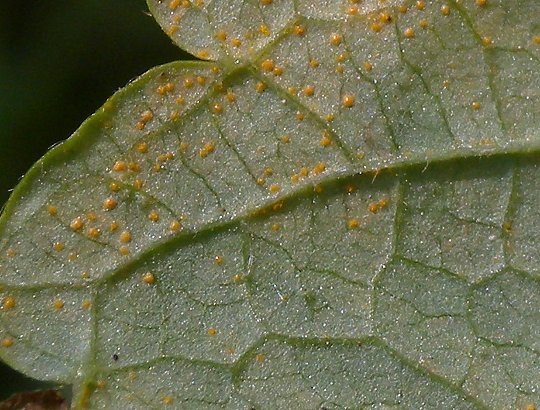
The upper leaflet surface is medium green or yellowish green and hairless (or nearly so), while the lower leaflet surface is light or whitish green and sparsely hairy along the undersides of primary veins. In addition, the lower leaflet surface usually has minute glandular hairs that can glisten in bright sunlight (a 10x hand lens may be necessary to see them). The petioles and rachises of the compound leaves are light green and sparsely hairy; they are flat or finely grooved along their upper surfaces, while their lower surfaces are convex. Pairs of stipules up to 1" long occur at the petiole bases of compound leaves. These stipules are either unlobed and lanceolate in shape, or they are divided into 2-3 lanceolate lobes. The central stem terminates in either an unbranched raceme or sparingly branched racemes of flowers. The racemes are spike-like in appearance and they are ½–1¼' long. If lateral racemes are present, they are shorter than the central raceme. The flowers are distributed alternately along each raceme. Each flower is about ¼" across or slightly larger in size, consisting of 5 yellow petals, 5 green sepals, 5-15 stamens, and a burry green hypanthium containing a pair of carpels (female reproductive organs). The rachis of each raceme is light to medium green, terete, sparsely hairy below, and short glandular-hairy above. The pedicels of the flowers are short (less than ¼" long).

The blooming period occurs from mid-summer to early autumn, lasting about 3 weeks. There is no noticeable floral scent. The burry fruits (mature hypanthia) are 3-4 mm. long and slightly less across; they are obconic-hemispheric below, tapering to a knobby apex above. Around the middle of each fruit, there are 2-3 rows of hooked spines that are widely spreading to ascending (mainly the latter). The obconic-hemispheric section of the fruit may have shallow longitudinal grooves, or such grooves may be lacking. The entire fruit is covered with very short glandular hairs. These fruits usually nod or hang downward from their pedicels. Each fruit contains are pair of seeds. The root system is fibrous, occasionally forming narrow spindle-shaped tubers.
Cultivation: The preference is partial sun to light shade, mesic to dry-mesic conditions, and soil containing loam, clay-loam, glacial till, or rocky material.
Range & Habitat: The native Woodland Agrimony is occasional in the southern half of Illinois and NE Illinois, while in the rest of the state it is uncommon or absent (see Distribution Map). Habitats include upland woodlands, upland savannas, rocky bluffs, and openings in upland woodlands. This plant is found in higher quality natural areas.

Faunal Associations: The flowers are cross-pollinated by Halictid bees, other small bees, Syrphid flies, and other flies. Insects that feed destructively on species of Agrimony (Agrimonia spp.) include the aphids Macrosiphum agrimoniellum and Macrosiphum pallidum, larvae of the gall fly Contarinia agrimoniae, larvae of the sawfly Fenella nigrita, and larvae of the moths Anacampsis agrimoniella and Coptotriche agrimoniella (Blackman & Eastop, 2013; Felt, 1917; Smith, 2006; Covell, 1984/2005; Microleps website, 2010). There is some evidence that White-tailed Deer browse on Woodland Agrimony (Agrimonia rostellata), reducing its abundance in wooded areas (Dávalos et al., 2014). The burry fruits can cling to the fur of mammals (cattle, sheep, deer), feathers of birds, and clothing of people, spreading the seeds to new areas.
Photographic Location: An opening in an upland woodland at Merwin Nature Preserve in McLain County, Illinois.

Comments: The different species of Agrimony (Agrimonia spp.) all have spike-like racemes of small yellow flowers and compound leaves that are odd-pinnate. Their compound leaves are unusual in having smaller secondary leaflets interspersed between the larger primary leaflets. Because they are similar in appearance, different species of Agrimony can be difficult to identify. Woodland Agrimony (Agrimonia rostellata) can be distinguished from these other species of Agrimony by examining its fruits: 1) its burry fruits tend to be smaller in size (3-4 mm. long), 2) they have fewer bristles that are spreading to ascending, and 3) they are more hemispheric below and develop a knob-like beak above, rather than being obconic below and with a more tapered beak above. In addition to its fruits, Woodland Agrimony can be distinguished from some species of Agrimony by the short glandular hairs on its floral stalks, the scarcity of secondary leaflets on its compound leaves, the presence of minute glandular hairs on the lower sides of its leaflets (this can be difficult to see), and its greater tendency to develop branching racemes of flowers. Overall, Woodland Agrimony tends to be less robust and smaller in size than other species of Agrimony within the state.